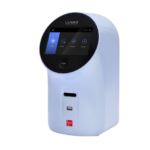Written by Lindsey Bunn, Syngene
CCD or CMOS? Before diving into the pros and cons of chemiluminescent western blot imaging, it’s important to understand what these phrases mean.
To put it simply, they are two different camera sensors.
CCD sensor technology has been around for many years. With CCD sensors, light hits the sensor and is converted into electrical charges that are transferred across the sensor and read out sequentially. This results in high-quality images with low noise levels.
CMOS sensors convert light into electrical signals at each pixel. This provides faster read-out and lower power consumption, which are advantageous features.

Choosing the right imaging system for your application is crucial for achieving sharp, high-quality images. Both technologies have advantages and disadvantages, but which is better for chemiluminescence western blotting depends on a few key factors.
In this article, we will explore the strengths and weaknesses of CCD and CMOS sensors to help researchers decide which is better suited for western blotting.
Chemiluminescent western blot detection involves light emission due to a chemical reaction (HRP and luminol). This light is often faint and requires sensitive imaging to capture the bands on the blot. Several key factors come into play when evaluating CCD versus CMOS sensors for this type of application, which will be discussed below.
Sensitivity
Sensitivity is arguably the most critical factor in chemiluminescent imaging, as the emitted light is often weak.
CCD sensors are the traditional choice for imaging low-light levels due to their ability to detect low-light levels with minimal noise. They typically have high quantum efficiency, which makes them more suitable for capturing faint chemiluminescent signals.
CMOS sensors, on the other hand, are more modern and have recently undergone many improvements in sensitivity. However, they are believed to currently fall short of CCD sensors when detecting extremely low-intensity light. For applications requiring maximum sensitivity, CCD sensors usually outperform CMOS.
Noise Performance
Ideally, when imaging chemiluminescent western blots, you want bright bands on a smooth, dark background, and to achieve this, you need a high signal-to-noise ratio (SNR).
CCD sensors excel in producing images with very low noise due to the way they handle the transfer of charge. This is particularly important for image captures requiring a long exposure time, which is very typical for chemiluminescence. CCD sensors often produce images with a high SNR.
CMOS sensors tend to have higher intrinsic noise than CCD sensors, especially during long exposure times. Modern CMOS designs have significantly improved to minimise noise, but CCD sensors have a significant advantage when comparing noise levels.
Dynamic Range
Dynamic range refers to the sensor’s ability to capture faint and bright signals on the same blot simultaneously. In chemiluminescent western blot imaging, it is important to detect high-abundance and low-abundance proteins in the same image without saturating the stronger signals.
CCD sensors are known for their wide dynamic range, which allows them to capture a broad spectrum of signal intensities. This is due to their high full-well capacity (the maximum amount of charge that each pixel in the CCD can store before it saturates).
CMOS sensors have progressed in increasing dynamic range, but top-end CCDs still outperform CMOS in this area. Some high-end CMOS sensors, HDR (high dynamic range), have processing techniques that improve the dynamic range, but for chemiluminescence, CCDs’ natural dynamic range gives them an edge..
Sensor Pixel Size
The Pixel size of a camera sensor plays a vital role in chemiluminescence imaging. It directly affects the SNR and sensitivity, positively impacting the quality of chemiluminescent images.

CCD cameras tend to have larger pixels compared to CMOS cameras. The advantage of larger pixels is that there is more surface area to collect photons, increasing the amount of light captured per pixel. When more photons hit a larger pixel, this generates a stronger signal, which in turn leads to an improved SNR, and therefore, the detection of fainter signals is improved. The read-out noise for larger pixels is reduced, contributing to sensitivity.
CMOS cameras often have smaller pixels, which capture less light because they have a smaller area to collect photons. In addition, CMOS cameras can have lower full-well capacity, meaning they can store less charge before saturating. When looking at pixel size, CCD sensors have the advantage over CMOS, but CMOS technology is catching up
Binning
Binning is a technique where adjacent pixels are combined into a “super-pixel” to increase sensitivity and improve SNR, but the downside is that this often leads to a loss in resolution.
In CCDs, binning occurs during the charge transfer process. When adjacent pixels are binned, their electrical charges are combined before being read. This allows the sensor to accumulate more light in the binned pixel area, improving sensitivity and reducing read-out noise, as the noise is applied to the entire binned region rather than each pixel. This results in a cleaner signal with less background noise, which is advantageous for weak signals like chemiluminescent Western blots.
In CMOS sensors, binning typically happens after each pixel has read out the signal. Since the read-out noise is applied to each pixel before the binning process, the noise level remains higher than CCD sensors. While binning can still increase signal strength by combining adjacent pixels, CMOS binning generally does not reduce the noise as effectively as CCD binning.
Speed and Frame Rates
While speed is not the highest priority in chemiluminescent Western blot imaging (as it typically requires longer exposure times), it may still be important if you’re dosing high-throughput experiments or need fast image acquisition.
CCDs, significantly high-sensitivity cooled CCDs, tend to be slower because of how the charges are transferred and read out.
CMOS sensors are designed for high-speed read-outs. Each pixel can be read individually, allowing for much faster image capture compared to CCDs. If speed is a priority, CMOS systems have a significant advantage.
Which One Should You Choose for Chemiluminescent Western Blots?
Ultimately, the choice between CCD and CMOS sensors for imaging chemiluminescent Western blots depends on your specific needs and priorities:
If your top priority is sensitivity, low noise, and wide dynamic range, and you’re working with faint signals (e.g., low-abundance proteins), a CCD camera is better. CCDs remain the gold standard for high-sensitivity applications like chemiluminescent Western blots because they capture weak signals with minimal noise.
CMOS sensors are designed for high-speed read-outs. Each pixel can be read individually, allowing for much faster image capture compared to CCDs. If speed is a priority, CMOS systems have a significant advantage.
If you prioritise speed, cost-effectiveness, and ease of use for routine or high-throughput experiments, and your signals are strong enough, a CMOS camera could be a more practical solution. CMOS cameras are advancing rapidly and can still provide excellent images for most Western blot applications, especially if sensitivity is not your primary concern.
By understanding the strengths of each sensor type, you can choose the imaging system that best suits your research needs and produce publication-quality results.
Contact us with any questions.



